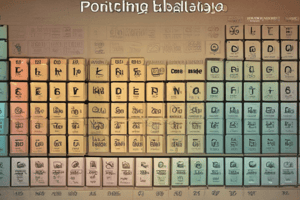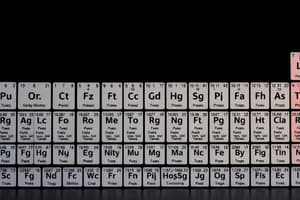Podcast
Questions and Answers
Imagine a sealed container of gas is heated. What describes the most likely behavior of the gas molecules?
Imagine a sealed container of gas is heated. What describes the most likely behavior of the gas molecules?
- The molecules will slow down and move closer together.
- The molecules will move faster and spread further apart. (correct)
- The molecules will maintain their speed and arrangement.
- The molecules will stop moving.
How did the discovery of noble gases change the structure of the periodic table?
How did the discovery of noble gases change the structure of the periodic table?
- It led to the removal of several transition metals.
- It caused a shift in the positions of alkali metals and alkaline earth metals.
- It led to the inclusion of a new group (Group 18) on the periodic table. (correct)
- It resulted in a reorganization based on atomic number instead of mass.
Mendeleev left gaps in his periodic table. What was his reasoning for doing so?
Mendeleev left gaps in his periodic table. What was his reasoning for doing so?
- He thought those spaces belonged to inaccurately measured elements.
- He ran out of elements to include and left the spaces for future scientists to fill.
- He believed that undiscovered elements existed and would fit into the table based on predicted properties. (correct)
- He assumed some elements were too rare to be discovered.
How did Mendeleev's approach to organizing the periodic table differ fundamentally from that of Henry Moseley?
How did Mendeleev's approach to organizing the periodic table differ fundamentally from that of Henry Moseley?
Consider an element located in Group 17 (halogens) and Period 3. How would its chemical reactivity compare to an element in Group 1 (alkali metals) of the same period?
Consider an element located in Group 17 (halogens) and Period 3. How would its chemical reactivity compare to an element in Group 1 (alkali metals) of the same period?
An element is located in Group 2, Period 4 of the periodic table. How would you expect this element to behave chemically?
An element is located in Group 2, Period 4 of the periodic table. How would you expect this element to behave chemically?
Fluorine (F) and chlorine (Cl) exhibit similar chemical behaviors. What characteristic do they share that primarily accounts for this?
Fluorine (F) and chlorine (Cl) exhibit similar chemical behaviors. What characteristic do they share that primarily accounts for this?
An element is found in Period 5 and Group 15. What chemical behavior would be expected for this element?
An element is found in Period 5 and Group 15. What chemical behavior would be expected for this element?
Considering the behavior of particles in different states of matter, which statement accurately compares the density differences between solids, liquids, and gases?
Considering the behavior of particles in different states of matter, which statement accurately compares the density differences between solids, liquids, and gases?
How does the particle theory of matter explain the behavior of a gas when it is compressed into a smaller volume?
How does the particle theory of matter explain the behavior of a gas when it is compressed into a smaller volume?
When a solid is heated, its particles gain energy. What is most likely to happen to the solid as it is heated?
When a solid is heated, its particles gain energy. What is most likely to happen to the solid as it is heated?
If you have an atom of Iron (Fe) with an atomic number of 26 and a mass number of 56 but it loses two electrons, what is the number of protons, neutrons, and the remaining electrons?
If you have an atom of Iron (Fe) with an atomic number of 26 and a mass number of 56 but it loses two electrons, what is the number of protons, neutrons, and the remaining electrons?
During freezing, how do water molecules behave?
During freezing, how do water molecules behave?
During evaporation, a liquid transforms into a gas. Which statement describes the molecular behavior during this phase change?
During evaporation, a liquid transforms into a gas. Which statement describes the molecular behavior during this phase change?
What principle, introduced by John Newlands, laid an early foundation for understanding the periodicity of elements, even though it had limitations?
What principle, introduced by John Newlands, laid an early foundation for understanding the periodicity of elements, even though it had limitations?
When a liquid freezes and becomes a solid, what changes occur at the particle level?
When a liquid freezes and becomes a solid, what changes occur at the particle level?
Flashcards
Effect of Heating on Molecules
Effect of Heating on Molecules
When a substance is heated, its molecules move faster and spread apart.
Noble Gases and Periodic Table
Noble Gases and Periodic Table
The discovery of noble gases led to adding a new group to the periodic table.
Mendeleev's Prediction
Mendeleev's Prediction
Mendeleev predicted undiscovered elements by identifying gaps in his periodic table.
Chemical Behavior of Group 17 Element
Chemical Behavior of Group 17 Element
Signup and view all the flashcards
Behavior of Group 2, Period 4 Element
Behavior of Group 2, Period 4 Element
Signup and view all the flashcards
Freezing of Water
Freezing of Water
Signup and view all the flashcards
Calcium's Similar Element
Calcium's Similar Element
Signup and view all the flashcards
Gases in Containers
Gases in Containers
Signup and view all the flashcards
Mendeleev's Periodic Table
Mendeleev's Periodic Table
Signup and view all the flashcards
Valence Electrons
Valence Electrons
Signup and view all the flashcards
Alkali Metals
Alkali Metals
Signup and view all the flashcards
Noble Gases
Noble Gases
Signup and view all the flashcards
Particle Theory
Particle Theory
Signup and view all the flashcards
Freezing Process
Freezing Process
Signup and view all the flashcards
Evaporation
Evaporation
Signup and view all the flashcards
Atomic Structure
Atomic Structure
Signup and view all the flashcards
Study Notes
Molecular Movement and Heating
- When a substance is heated, its molecules move faster and spread apart.
Noble Gases and Periodic Table
- The discovery of noble gases led to the inclusion of a new group in the periodic table.
Mendeleev's Predictions
- Mendeleev noticed patterns in element properties and predicted the existence of undiscovered elements by anticipating gaps in his table.
Chemical Behavior Prediction
- Elements in the same group of the periodic table exhibit similar chemical behavior due to the same number of valence electrons. Elements in the same period show trends in reactivity.
Element Properties and Period/Group
- Elements in Period 5 and Group 15 are likely to form covalent bonds with elements in Group 17. Elements in Group 2 and Period 4 tend to form +2 ions with nonmetals.
Effect of Heating on Solids
- When a solid is heated, the particles gain energy and move faster. This leads to melting, where particles are still closely packed, but can move past each other.
Freezing Process
- During freezing, the molecules in liquid water move slower, become more orderly, and form a rigid structure.
Atomic Structure
- An atom of sulfur (atomic number 16, mass number 32) contains 16 protons, 16 electrons, and 16 neutrons.
Mendeleev's Periodic Table Gaps
- Mendeleev left gaps in his periodic table for undiscovered elements, anticipating that undiscovered elements would have similar properties to those nearby.
Element Similarity
- Elements in the same group on the periodic table have similar chemical properties because they have the same number of valence electrons. Magnesium is most similar to Calcium.
Periodic Table Organization
- Dmitri Mendeleev is recognized for organizing elements primarily based on atomic mass and properties.
Gas Expansion
- Gases expand to fill their containers because the particles move freely in all directions with little attraction to each other.
Melting Process
- When ice (solid) melts to become liquid, the molecules move further apart and their motion speeds up.
Periodic Table Arrangement
- Mendeleev arranged elements in his periodic table by increasing atomic mass.
Valence Electrons
- Elements in the same column (group) of the periodic table share similar chemical properties due to having the same number of valence electrons.
Reactive Metals
- Alkali metals are the most reactive group of metals .
Nonreactive Elements
- Noble gases are generally non-reactive.
Periodic Table Trends - Reactivity
- Fluorine and chlorine exhibit similar reactivity.
Solid Properties
- Solids have a fixed shape and volume because their particles are tightly packed and vibrate in place.
Periodic Table Arrangement - Atomic Number
- Henry Moseley arranged the periodic table by increasing atomic number instead of atomic mass.
Newlands' Contribution
- John Newlands developed the concept of the Law of Octaves, which contributed to the organization of elements.
Gas Compression
- When a gas is compressed, the molecules are pushed closer together, and their motion decreases.
Atomic Structure Calculation
- An atom of iron (Fe) with atomic number 26 and mass number 56, has 26 protons, 30 neutrons and 26 electrons. Similarly, a carbon atom (atomic number 6, mass number 12) has 6 protons, 6 electrons, and 6 neutrons.
Density
- Liquids are denser than gases because their particles are closer together.
Freezing Process - Molecular Change
- Freezing transitions a liquid to a solid by slowing the particles causing them to tightly pack.
Evaporation
- When a liquid evaporates, molecules gain energy, move faster, and spread further apart to become gas.
Studying That Suits You
Use AI to generate personalized quizzes and flashcards to suit your learning preferences.




